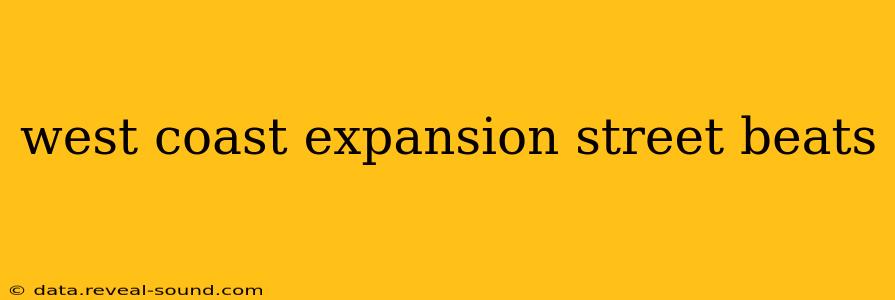The West Coast's influence on hip-hop is undeniable. From the smooth G-funk sounds of the early 90s to the more aggressive, trap-influenced styles of today, the region has consistently pushed the boundaries of the genre. This exploration delves into the evolution of West Coast street beats, examining key influences, defining characteristics, and the artists who shaped its unique sound.
What Makes West Coast Hip Hop Beats Unique?
West Coast hip-hop beats are characterized by a distinct sonic palette that sets them apart from their East Coast counterparts. Several key elements contribute to this unique sound:
-
G-Funk: This subgenre, pioneered by Dr. Dre and others in the early to mid-90s, is defined by its heavy use of synthesizers, mellow melodies, and a laid-back groove. The use of synthesizers, particularly the Roland 808 and other classic keyboards, created a distinctive, smooth, and often sensual sound.
-
Sampling: While sampling is a cornerstone of hip-hop production across all regions, West Coast producers often favored funk, soul, and jazz samples, resulting in a warmer, more melodic sound compared to the sometimes harder-edged samples used in East Coast productions.
-
Instrumentation: In addition to synthesizers, West Coast beats frequently incorporate live instrumentation, such as guitars, bass, and horns, adding depth and texture. This blending of synthetic and organic elements is a hallmark of the region's sound.
-
Tempo and Groove: West Coast beats often feature a slower tempo and a more laid-back groove than some East Coast styles, contributing to the relaxed, almost hypnotic feel of much of the music.
How Did the West Coast Sound Evolve?
The West Coast's hip-hop sound hasn't remained static. It has undergone significant evolution, influenced by various factors:
-
Early Influences: The early West Coast scene drew inspiration from funk, soul, and disco, setting the stage for the melodic and groove-oriented sounds that would define the region.
-
The Rise of G-Funk: Dr. Dre's The Chronic (1992) is widely considered a landmark album that cemented G-Funk as a dominant force in West Coast hip-hop. This sound influenced countless artists and producers for years to come.
-
Post-G-Funk Innovation: As the 90s progressed, West Coast hip-hop diversified, incorporating elements of gangsta rap, conscious hip-hop, and other subgenres. Artists experimented with different sounds and styles, pushing the boundaries of the genre.
-
The Influence of Trap: More recently, trap music has had a significant impact on West Coast hip-hop, leading to a blend of hard-hitting 808s and melodic hooks. This fusion continues to evolve and shape the sound of modern West Coast hip-hop.
What Are Some Key Artists Who Shaped West Coast Street Beats?
Numerous artists have played pivotal roles in shaping the sound of West Coast hip-hop. Some of the most influential include:
-
Dr. Dre: His pioneering work in G-Funk fundamentally changed the landscape of West Coast hip-hop.
-
Snoop Dogg: His laid-back delivery and iconic collaborations with Dre helped define the G-Funk era.
-
Ice Cube: His hard-hitting lyrics and aggressive style offered a counterpoint to the smoother sounds of G-Funk.
-
Warren G: Known for his smooth production and signature G-Funk sound.
-
DJ Quik: A highly influential producer known for his funk-infused beats and innovative sampling techniques.
-
N.W.A: While not solely a West Coast sound, their influence was massive, paving the way for the more polished and commercially successful artists of the 90s.
What's the Future of West Coast Hip Hop Beats?
The future of West Coast hip-hop beats is likely to remain dynamic and ever-evolving. The fusion of trap and melodic elements will likely continue, with producers experimenting with new sounds and technologies. The region's rich musical heritage and innovative spirit suggest a vibrant and exciting future for West Coast street beats.
Are West Coast Beats Different From East Coast Beats?
Yes, West Coast and East Coast hip-hop beats have distinct sonic characteristics. East Coast beats are often characterized by harder-hitting drums, sharper samples, and a more aggressive overall feel. West Coast beats, as discussed above, tend to be smoother, more melodic, and groove-oriented. These stylistic differences reflect the distinct cultural landscapes and musical influences of each region.
What are some examples of popular West Coast hip hop songs?
Numerous songs exemplify the distinctive West Coast sound. Examples include:
- "Deep Cover" - Dr. Dre ft. Snoop Dogg: A classic example of G-Funk.
- "Nuthin' but a 'G' Thang" - Dr. Dre ft. Snoop Dogg: Another quintessential G-Funk track.
- "California Love" - 2Pac ft. Dr. Dre & Roger Troutman: A massive hit that embodies the spirit of West Coast hip-hop.
- "Gin and Juice" - Snoop Dogg: A quintessential example of laid-back West Coast style.
- "Check Yo Self" - Ice Cube: A hard-hitting example contrasting the smoother G-Funk style.
This exploration offers only a glimpse into the rich and multifaceted history of West Coast street beats. The region's ongoing contributions to hip-hop continue to shape the genre's global landscape, promising a future filled with fresh sounds and innovative expressions.
